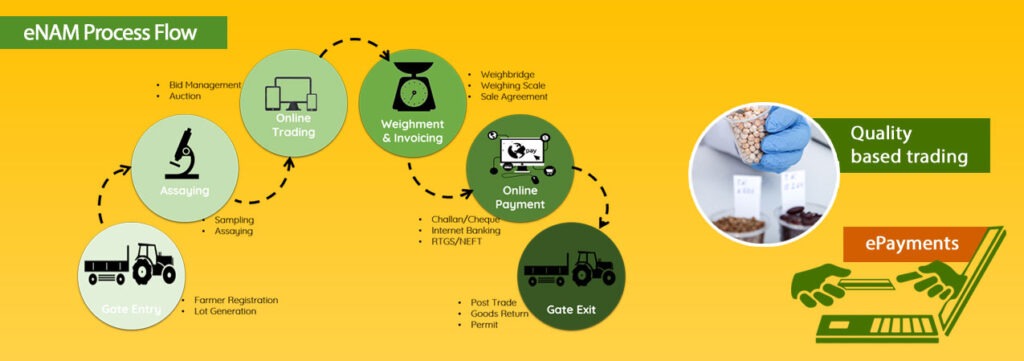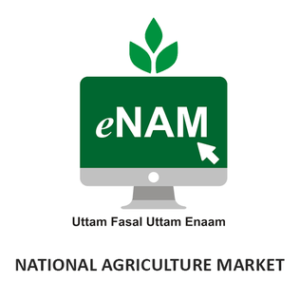The National Agriculture Market (eNAM) serves as an electronic trading portal connecting Agricultural Produce Market Committees (APMC) mandis. Launched under the aegis of the Small Farmers Agribusiness Consortium (SFAC) and the Ministry of Agriculture and Farmers’ Welfare, eNAM is not merely a parallel structure but a digital bridge that enhances the traditional mandi system.
Connecting Stakeholders
eNAM brings together farmers, traders, and various stakeholders in the agricultural supply chain, aiming to establish a cohesive national market for agricultural commodities. This electronic platform was conceptualised to streamline agricultural marketing procedures, foster transparency, and facilitate real-time price discovery, creating a more efficient marketplace for all participants.
Also Read https://yadfarm.com/national-agriculture-market-transforming-farmers/
Unlike creating a separate entity, eNAM complements the traditional mandi system by providing an online platform for buyers and sellers to engage in agricultural trade. The initiative has been an ongoing effort, evolving to meet the dynamic needs of farmers and traders. Through eNAM, stakeholders gain access to a nationwide platform that allows buyers from any location, even outside the mandi or state, to participate in local-level trading, leveraging the physical infrastructure of APMC mandis.

The overarching vision of eNAM is to bring uniformity to agriculture marketing, eliminate information asymmetry, and ensure fair price discovery based on actual demand and supply. By integrating technology into the existing system, eNAM seeks to benefit both farmers and traders by providing a transparent and efficient marketplace.
Key Features and Reforms
One of the key features of eNAM is the requirement for states to implement three crucial reforms to integrate with the platform effectively:
- Unified Trading License: States need to adopt a unified trading license, simplifying the process for farmers and traders to engage in cross-state transactions.
- Single-Point Levy of Market Fees: eNAM promotes efficiency by introducing a single-point levy of market fees, reducing bureaucratic complexities associated with multiple fee structures.
- Provisions for e-Auction or e-Trading: To ensure a seamless transition to digital platforms, states must implement provisions for e-auction or e-trading, allowing stakeholders to participate in the trading process online.
Registration Guidelines for Farmers
Farmers can register on the eNAM platform by visiting the official website, selecting “Registration Type” as “Farmer,” and choosing the desired APMC. The registration process involves email verification, approval from the selected APMC, and receiving a permanent login ID for complete access.
Registration Guidelines for Traders
Traders follow a similar process, selecting ‘Registration Type’ as ‘Trader’, providing necessary details, submitting for approval to the selected APMC, and receiving a permanent login ID upon successful verification.
Registration Guidelines for Other Stakeholders
Apart from farmers and traders, even FPOs/FPCs, Mandi Boards, and Logistics Providers can register on the eNAM website, fostering inclusivity and efficiency in India’s agricultural trade. The digital transformation promises to bring about positive changes, ensuring a fair and transparent marketplace for all stakeholders.
Benefits of eNAM
- Transparency: eNAM ensures transparency in pricing and transactions, benefiting both farmers and traders.
- Efficiency: The platform reduces intermediaries, streamlining the buying and selling process.
- Market Access: Farmers get access to a larger market, beyond their local mandis.
- Price Discovery: Real-time price information helps farmers make informed decisions.
- Reduced Wastage: Direct procurement reduces wastage and improves efficiency in the supply chain.
Challenges and Solutions
While eNAM has been successful in many aspects, challenges remain, such as lack of awareness among farmers, connectivity issues, and resistance from traditional traders. To address these challenges, the government and implementing agencies are working on awareness campaigns, improving infrastructure, and providing technical support to users.
Case Studies of eNAM Success
Several states have seen success stories with eNAM implementation. For example, in Madhya Pradesh, eNAM has enabled farmers to get better prices for their produce by connecting them directly with buyers across the country. In Karnataka, eNAM has reduced the role of middlemen, benefiting both farmers and consumers.
Future of eNAM
The future of eNAM looks promising, with continued government support and technological advancements. As more states join the platform and more farmers and traders embrace digital trading, eNAM has the potential to revolutionize India’s agricultural marketing landscape.
Conclusion
eNAM has emerged as a game-changer in India’s agricultural marketing system, empowering farmers and traders with a transparent, efficient, and nationwide platform for trade. By integrating technology with traditional mandis, eNAM has paved the way for a more inclusive and competitive agricultural market.
Click Here To Know More Govt Schemes and Latest News Articles
FAQs
- What is eNAM?
- eNAM stands for Electronic National Agriculture Market, an online trading platform for agricultural commodities in India.
- Who can register on eNAM?
- Farmers, traders, FPOs/FPCs, Mandi Boards, and Logistics Providers can register on eNAM.
- How does eNAM benefit farmers?
- eNAM provides farmers with access to a larger market, ensures transparency in pricing, and reduces intermediaries.
- What are the key features of eNAM?
- Unified Trading License, Single-Point Levy of Market Fees, and Provisions for e-Auction or e-Trading are key features of eNAM.
- What is the future of eNAM?
- The future of eNAM looks promising, with continued government support and technological advancements.










